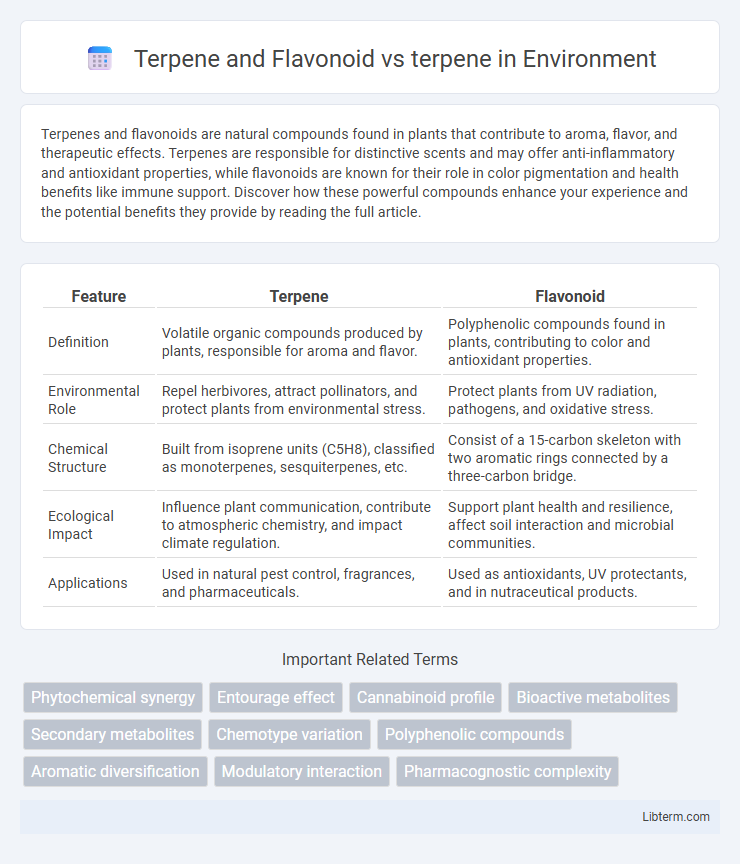Terpenes and flavonoids are natural compounds found in plants that contribute to aroma, flavor, and therapeutic effects. Terpenes are responsible for distinctive scents and may offer anti-inflammatory and antioxidant properties, while flavonoids are known for their role in color pigmentation and health benefits like immune support. Discover how these powerful compounds enhance your experience and the potential benefits they provide by reading the full article.
Table of Comparison
| Feature | Terpene | Flavonoid |
|---|---|---|
| Definition | Volatile organic compounds produced by plants, responsible for aroma and flavor. | Polyphenolic compounds found in plants, contributing to color and antioxidant properties. |
| Environmental Role | Repel herbivores, attract pollinators, and protect plants from environmental stress. | Protect plants from UV radiation, pathogens, and oxidative stress. |
| Chemical Structure | Built from isoprene units (C5H8), classified as monoterpenes, sesquiterpenes, etc. | Consist of a 15-carbon skeleton with two aromatic rings connected by a three-carbon bridge. |
| Ecological Impact | Influence plant communication, contribute to atmospheric chemistry, and impact climate regulation. | Support plant health and resilience, affect soil interaction and microbial communities. |
| Applications | Used in natural pest control, fragrances, and pharmaceuticals. | Used as antioxidants, UV protectants, and in nutraceutical products. |
Introduction to Terpenes and Flavonoids
Terpenes and flavonoids are essential bioactive compounds found in plants, each contributing unique aromatic and therapeutic properties. Terpenes primarily influence the scent and flavor profiles of plants, playing a crucial role in environmental interactions and potential health effects. Flavonoids, on the other hand, are known for their antioxidant and anti-inflammatory benefits, complementing the effects of terpenes to enhance overall plant efficacy.
What Are Terpenes?
Terpenes are organic compounds produced by plants that contribute to their aroma, flavor, and therapeutic properties, playing a crucial role in essential oils and natural extracts. Flavonoids, while also plant-based compounds, differ by primarily offering antioxidant and anti-inflammatory benefits rather than influencing scent or taste. Terpenes specifically affect the sensory experience and therapeutic effects of herbs, making them key targets in plant-based medicine and aromatherapy research.
Understanding Flavonoids
Flavonoids are a diverse group of phytonutrients found in many plants, playing a crucial role in the coloration, flavor, and potential health benefits of fruits and herbs. Unlike terpenes, which primarily contribute to aroma and therapeutic effects through volatile oils, flavonoids exert antioxidant, anti-inflammatory, and immune-supporting properties by interacting with cell signaling pathways. Understanding flavonoids enhances the appreciation of their synergistic effects when combined with terpenes in botanical extracts, offering a broader spectrum of wellness benefits.
Terpenes vs Terpenes Alone: Key Differences
Terpenes are organic compounds responsible for the aroma and therapeutic properties of many plants, with variations influencing their effects. Flavonoids, often found alongside terpenes, contribute antioxidant and anti-inflammatory benefits, enhancing the overall bioactivity of botanical extracts. Compared to terpenes alone, the combination with flavonoids creates a synergistic effect, improving potency and offering a broader range of health benefits.
The Entourage Effect: Terpenes and Flavonoids Together
Terpenes and flavonoids work synergistically to enhance the therapeutic benefits of cannabis through the Entourage Effect, where their combined presence amplifies the plant's overall efficacy. While terpenes contribute aromatic qualities and interact with cannabinoid receptors, flavonoids provide antioxidant and anti-inflammatory properties that complement terpene activity. This collaboration between terpenes and flavonoids optimizes the modulation of cannabinoid effects, resulting in a more balanced and potent medicinal experience.
Benefits of Combining Terpenes and Flavonoids
Combining terpenes and flavonoids enhances the therapeutic effects of plants by leveraging their synergistic properties, resulting in improved anti-inflammatory, antioxidant, and antimicrobial benefits. Terpenes contribute aroma and mood enhancement, while flavonoids offer potent antioxidant capacity and cellular protection. Together, these compounds optimize the body's response to natural treatments and support overall wellness more effectively than terpenes alone.
How Terpenes Work in Isolation
Terpenes work in isolation by interacting directly with the body's endocannabinoid system, primarily influencing CB1 and CB2 receptors to produce specific therapeutic effects such as anti-inflammatory or analgesic responses. In contrast, flavonoids contribute synergistically by enhancing or modulating these effects through antioxidant and neuroprotective properties, but terpenes alone target receptor pathways more directly. Understanding terpene activity without flavonoids highlights their distinct role in signaling and receptor binding, crucial for targeted phytochemical-based treatments.
Synergistic Effects: Terpenes and Flavonoids in Cannabis
Terpenes and flavonoids in cannabis interact synergistically to enhance therapeutic effects beyond what terpenes alone provide. Terpenes contribute aromatic properties and modulate psychoactive effects, while flavonoids offer anti-inflammatory and antioxidant benefits, creating a comprehensive bioactive profile. This synergy, often described as the entourage effect, optimizes the plant's medicinal potential through combined biochemical pathways.
Applications in Medicine and Wellness
Terpenes and flavonoids both exhibit significant therapeutic properties, with terpenes primarily known for their anti-inflammatory, analgesic, and antimicrobial effects, making them valuable in pain management and infection control. Flavonoids contribute antioxidant, antiviral, and neuroprotective benefits, enhancing cognitive health and reducing oxidative stress, which supports chronic disease prevention. The combined use of terpenes and flavonoids in medical and wellness applications maximizes synergistic effects, improving overall efficacy in natural remedies and phytopharmaceutical formulations.
Conclusion: Choosing Between Terpene Blends and Solo Terpenes
Terpene blends offer a complex profile of aromatic compounds that can enhance the overall therapeutic effects through synergistic interactions, while solo terpenes provide targeted benefits by isolating specific compounds for precise outcomes. Flavonoids complement terpenes by adding antioxidant, anti-inflammatory, and neuroprotective properties that contribute to a more holistic health effect. Selecting between terpene blends and solo terpenes depends on the desired specificity of effects and the potential benefits of flavonoids to amplify the entourage effect for a more comprehensive wellness experience.
Terpene and Flavonoid Infographic

 libterm.com
libterm.com